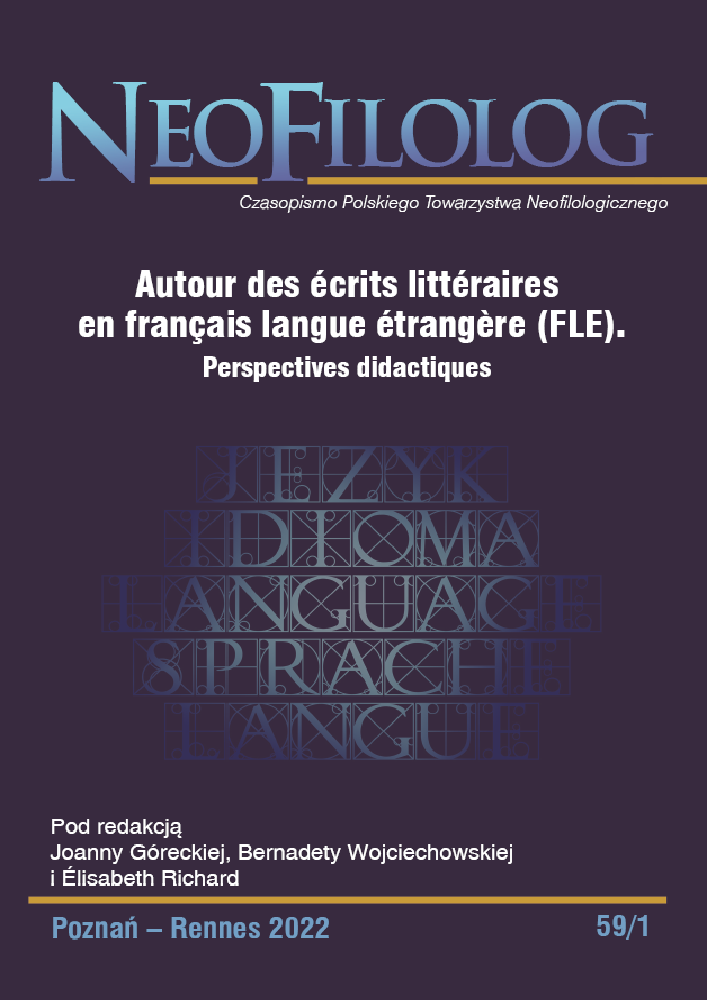Abstract
Current research on interculturality in foreign language teaching focuses on the development of the intercultural personality of the learner based on his social representations. In this context, the introduction of crime fiction in French foreign language teaching makes it possible to take the complexity of the human personality more efficiently into account when developing the intercultural competence of the learner. Based on a thematic analysis of the novel Derrière les panneaux il y a des hommes (Behind the Panels There Are Men) by Joseph Incardona, which aims at highlighting the references to French culture in the text, and from a linear analysis centered on the characters and their complex personalities, the article proposes to apply the cultural and intercultural approaches of language didactics to literature. In this way, in order to develop cultural competence, the learners first learn to identify the cultural clues referring to French society in the text. Then, they learn to adopt a positive attitude of openness towards others through the characters of the novel to develop their intercultural competence.
References
Aase L., Fleming M., Pieper I., Sâmihaian F. (2017), Les enseignements de la littérature pour une éducation plurilingue et interculturelle, (in :) Beacco J.-C., Coste D. (dir.), L'éducation plurilingue et interculturelle. La perspective du Conseil de l'Europe. Paris : Didier, 158-175.
Abdallah-Pretceille M., Porcher L. (1996), Éducation et communication interculturelle. Paris : PUF.
Amossy R., Herschberg Pierrot A. (2015), Stéréotypes et clichés. Paris : Armand Colin.
Bakešová V. (2020), La littérature, outil toujours actuel dans l'enseignement de FLE. « Romanistica Comeniana », n° 2, 63-76.
Beacco J.-C. (2018), L'altérité en classe de langue. Pour une méthodologie éducative. Paris : Didier.
Conseil de l'Europe (2001), Cadre européen commun de référence pour les langues : apprendre, enseigner, évaluer. Strasbourg : Didier.
Cuq J.-P. (2003), Dictionnaire de didactique du français langue étrangère et seconde. Paris : CLE international.
Debyser F. (1975), Lecture de civilisation, (in :) Beacco J.-C., Lieutau S. (dir.), Mœurs et mythes. Paris : Hachette/Larousse, 10-17.
Dufays J.-L. (1994), Stéréotype et littérature. L'inéluctable va-et-vient, (in :) Goulet A. (dir.), Le Stéréotype. Caen : Presse universitaire de Caen, 77-89. https://doi.org/10.4000/books.puc.9702
Galisson R. (1988), Cultures et lexicultures. Pour une approche dictionnairique de la culture partagée. « Annexes des Cahiers de linguistique hispanique médiévale », n° 7, 325-341. https://doi.org/10.3406/cehm.1988.2133
Hall E. T. (1976), Beyond Culture. New York : Anchor Books.
Incardona J. (2015), Derrière les panneaux il y a des hommes. Le Bouscat : Finitude.
Malinovská Z. (2020), Le roman noir de Joseph Incardona : un prétexte pour capter le présent, « World Literature Studies », n° 2, 4-13.
Moirand, S. (1979), Situations d'écrit. Compréhension, production en langue étrangère. Paris : CLE international.
Peytard, J. (1988), Des usages de la littérature en classe de langue, « Le Français dans le monde. Recherches et applications (numéro spécial, mars 1988) », 8-17.
Porcher L. (2004), L'enseignement des langues étrangères. Paris : Hachette.
Reichwalderová E. (2021), Urbánny priestor v súčasnej španielskej literatúre. J. J. Millás a jeho postmoderná vízia. « Development of Urban Culture. / Rozvoj urbánnej kultúry. Zborník z medzinárodnej vedeckej konferencie ». Banská Bystrica: DALI-BB, 252-263.
Tagliante C. (2006), La classe de langue. Paris : CLE international.
Zázrivcová M. (2021), Quand la force du roman noir repose sur sa langue, (in :) Jambor J., Souček J., Zázrivcová M. (dir.), Aktuálne spoločenské problémy v súčasnom kriminálnom románe na príklade textov z nemeckej, francúzskej a slovenskej jazykovej oblasti. Prešov: Filozofická fakulta, 209-229.
License
Copyright (c) 2022 Neofilolog

This work is licensed under a Creative Commons Attribution-NoDerivatives 4.0 International License.
Authors
Authors of texts accepted for publication in Neofilolog are required to complete, sign and return to the Editorial team’s office the Agreement for granting a royalty-free license to works with a commitment to grant a CC sub-license.
Under the agreement, the authors of the texts published in Neofilolog grant Adam Mickiewicz University in Poznań a non-exclusive, royalty-free license and authorize the use of Attribution-NoDerivatives 4.0 International (CC BY-ND 4.0) Creative Commons sub-license.
The authors retain the right to the free disposal of the work.
Users
Interested Internet users are entitled to use works that have been published in Neofilolog since 2017, under the following conditions:
▪ attribution – obligation to provide, together with the distributed work, information about the authorship, title, source (link to the original work, DOI) and the license itself.
▪ no derivatives – the work must be preserved in its original form. Without the author's consent, it is not possible to distribute the modified work in the form of translations, publications, etc.
Copyrights are reserved for all texts published since 2017.
Miscellaneous
Adam Mickiewicz University in Poznań retains the property right as a whole (layout, graphic form, title, cover design, logo etc.).

